The Model Boat Builders of Bequia
© 2021 David H.Lyman
Published in Caribbean Compass Magazine, XXX, 2021
“I want to build another boat,” Havana, my son tells me. He’s 9, and has been building little boats since he was 5. First out of Legos, then creating his own designs using of Lego parts, then scavenging around my boat shop for scraps of wood he can fashion into something at looks like a boat. On our way south to the islands on Searcher on our Bowman 57, he fashioned a tinny boat out of pieces of scrap pine, painted it and fixed a screw-eye in the bow to which he could towed behind the dinghy. He and I have visited boat shops and yacht yards all up and down the East Coast, watching boats in various stages of construction and restoration.
“They build boats in Bequia,” I tell him. “We’ll be there in a few days.” (Read David’s story “Sailing Down to Bequia” in the August 2020 issue of Caribbean Compass)
Bequia has a boat building tradition that goes back two hundred years. From wooden, hand-hewn, 30-foot, open whale boats to 60-foot coastal schooners, boat-building has been a way of life for these islanders. The tradition is alive today. The Bequia Boat Builders are turning out whale boats, coastal schooners, even custom mega-yachts, the only difference is the size. Bequia is the center of model boat building in the Caribbean.
“Well find someone on Bequia to help you build your boat. They’ll have more the tools.” Little did I know, they had less than I had aboard.
We arrived just before Christmas and anchored in Lower Bay, away from the mooring field, now crowded with yachts from the ARC Rally. Out here the water is clearer, the breeze is fresher.
After cleared in at Government House, the girls went in one direction, Havana and I in another. We were looking for boat yards.
We met Marvin, a model boat builder with a shop on Front Street, just up the hill from the open air market. The shop had small and large scale model whale boats, some as large as two-feet, others as small as 12-inches, all meticulously carved, varnished and painted in the bright colors like Bequia’s traditional long whale boats. The detail is incredible. Oars, harpoons and lances, line buckets, sailing rig laid out along the thwarts. On display were half models and replicas of some large, sleek yachts, some completed on commission over the summer waiting to be picked up by the yacht owner when they arrived later in the season. But, there was no workshop.
Further on along Front Street we came to a sign that read: Stewart Oliver’s “Original” Model Boat Shop. Benson, a tall strapping Bequian, had taken over the showroom and workshop. It was located across from Caribbean Yacht Services, set back from the road, behind a large breadfruit tree. (Since sold and replaced by The Sailors Bar and Grill).
The walls of the showroom were lined with shelves and display cases, crowded with finished models of all sizes, More than 50 finished models from small whale boats to 36-inch replicas of mega-yachts. We forums Benson “out back” in the workshop, siting in a nest of wood chips, sawed planks, tools and half finished models. Ηe was not alone. Other men were their chip points, carving, whittling, sanding their models, amid non-stop teasing, gossip, foot ball scores, and put-downs. All this in Patois, a West Indian dialect of French, English, and Creole.
We stood in the doorway watching the men. No electrical tools were in sight, not even an electric light. There were hand saws, machetes, chicles, and hand planers. A large, stand-up vice held a block of wood being shaped into a hull under the sharp edge of a hand planer. Pots of International paints and Epiphanies varnish sits in a corner. Sheets of cardboard stacked along one wall used for boxes to shipped large models off island for yachtsmen and tourists. Windows and doors open to the breeze off Admiralty Bay. Well worn stools and work benches provide working space for three or four men. Half finished models in various states of completion are stacked on a table, others hung from the ceiling, paint and varnish drying.
Benson noticed us and asked if he could help.
“My son wants to make a small model sail boat, one that can actually sail,” I said. “We are interest to see how you make your models.”
“You want to make a model?” Benson asked Havana, ignoring me.
“Yes. Can I?”
“Depends. You got any wood?”
“Maybe,” Havana looked up at me. “Do we?” He asked.
“I have a 2 by 12 plank of pine on board our boat,” I told Benson. “I can cut it up and glue it together to make a blank,” I told him. Behind one of the cabin seats I stow wood scraps, knowing I’ll find a use for them down the road.
“You bring da wood,” Benson said. “I’ll get her shaped. Your boy can do the rest.”
Benson makes display models, works of art that reside on wealthy boat owners’ mantels, not bobby about on the bay, but he knew of one model builder that had built boats that did sail . . . and sail well. The next morning, one of Benson’s friend brought in a sailing model. It measured 24-inches long, with a beam of 6-inches and a hull draft of 4.5 inches. The long, weighted keel was another 10-inches and the mast was taller than the boat was long. This was the boat Havana wanted to build. Benson said he’d help Havana get started, but he had no gum wood available.
Back on Searcher, I stripped the plank down the middle, with my electric skill saw, creating four narrow planks. These would be stacked and glued on top of each other to form the hull.
Back at the shop the next morning, Havana and Benson discussed a basic hull shape for his model. The hull would be 20-inches long, 5.25 inches wide and 4.5 inched deep, to which the fin keel would be fitted. Benson looked over our pine, shaking his head.
“Too many knots . . . . see. It’s checked here, and here. You don’t know how far into the wood this check goes. It could open up later as it dries.”
But this was what we had so Benson got to work. He laid out the dimensions on the deck plank, using pins to mark the various points along the sheer of the hull. An old saw blade was used as a batten to create a smooth curve along the pins marking out the hull’s edge. Then, he got to work with his cutlass, a machete that had lost half its width from repeated sharpening, which he did frequently while hacking away the excess wood with a skilled eye and hand. The boat’s shape came to life. The three blanks now roughed in were married together and glued up with West epoxy. Next morning, Benson and Havana would begin to refined the shape using hand planes.
On our way in the following morning, we met another boat builder. Sam Hermiston was a 12 year old Scot living board his family’s ketch also anchored in the harbor. Sam was fishing off the dinghy dock when we pulled up.
“You building a model boat at Benson’s,” he asked in a decided Scots accent, spying the wood blank in Havana’s hands. “I built one there too.” He reeled in his fishing line, put down his pole, and off we all went to Benson’s. The boys got on famously, sharing an interest in models and in boats. Later that afternoon, we took Sam out to his family’s ketch, Sea Warrior, so he could show us his model. The small 14-inch model, made from gum wood, had been hollowed out and deck over, to make it lighter. It was sloop rigged, with a tall mast, self-tending jib, deep, weighted keel and no rudder. Sam climbed into our dinghy, set his model gently in the water and gave her a shove. Off she went as straight as an arrow in the 10 knot breeze that ruffled the harbor. The tiny model laying over in the gusts, righting itself and bobbing along in the chop. We followed it in our dinghy, the boys were all smiles to see the small boat flying along, all by itself, no remote controls, no battery powered motor, just the breeze and the magic of the boat builder’s craft to harness the wind.
Back at the shop, under Benson Havana’s hull was clamped in the vice and Benson showed Havana how to use hand planer to completed the job of squaring off the outline of the laminated planks. Benson then drew a line on the hull where he figured would be the turn of the bilge, where the waterline might be. With his machete, he chopped away the excess wood creating the rough shape of the boat’s under body. More planning as the profile of the boat took shape. Next would be carving away the wood from stern to the stern to create the completed shape of the hull. When completed, Havana could begin the long, tedious task of sanding the hull. We tested the hull’s buoyancy in sea water. It sat too low in the water. To lighten the boat, we’d have to remove wood from inside of the hull, then deck it over. That is, if Havana wanted his model to actually sail.
“Do you make any models that actually sail?” Havana asked Benson.
“No, but many of the kids do,” He replied. “We have a model boats race here every year during the Bequia Easter Regatta. Here I show you one of the winners.” From off a shelf came a crude contraption, made from half a coconut, rigged with a mast and long bowsprit and rags for sails. “The lads put a few stones in the coconut for ballast.”
But, it would be some time before Havana’s boat would feel the wind and taste the water, as he had a lot of sanding to do. This, to be followed by 2 coats of primer, sanding between each coat, then 2 to 3 coats of top side paint, bottom paint, boot strip, then a deck paint, the mast and boom needed to be shaped, then stays and shrouds and halyards rigged. Life-lines? Deck hardware might be added, and finally the name needed to be painted on the stern.
As we cruised through the Caribbean islands, Havana was busy sanding and designing the rig and deck layout for his model boat, often taking an idea here and there from the yachts we pass or that anchored next to us. Whether his model ever makes it into the water or not as important as the lessons he has learned along the way. The patience it takes and the skill of hand and tool that Benson imparted, along with the feel of the wood . . . it’s the process not the product that teaches.
While spending a month in English Harbor on Antigua, we visited the local ship yard and had a piece of sheet aluminum cut out for the keel. A nearby wood working shop, cut out a piece of scrap mahogany plywood for the deck. But, it wasn’t until we returned to Maine and a proper workshop that Havana fished his model.
It did sail once, but needed to be lightened more, and more weight added to the bottom of the keel for stability. She was a bit too tender.
Havana’s model sit here in our Maine house, a reminder that his ideas can be make real, all it takes is patience and acquiring skills ands those he is now learning. He’s now 21, off to college in the UK, studying marine engineering and yacht design at Solent University.
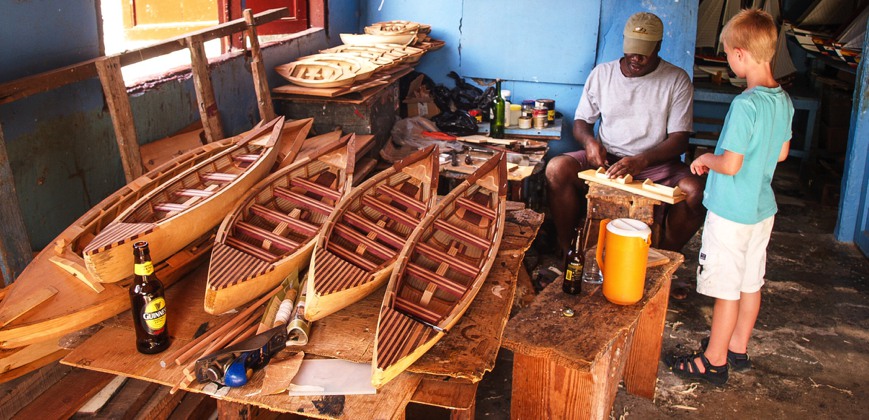
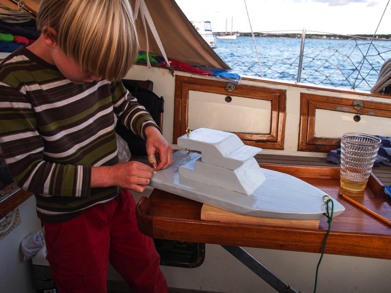
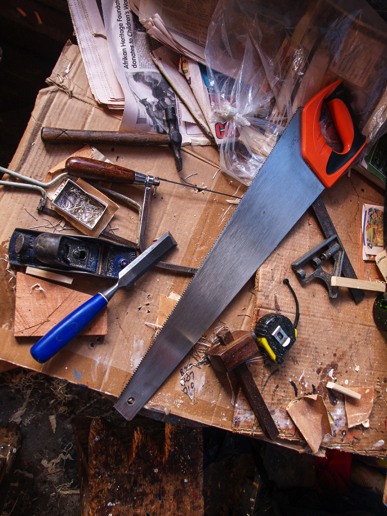
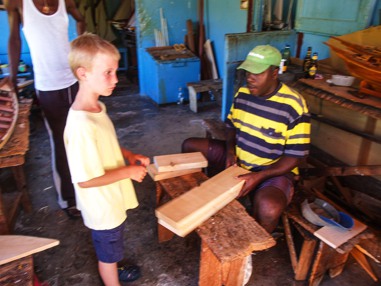
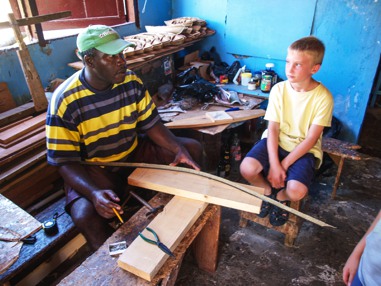
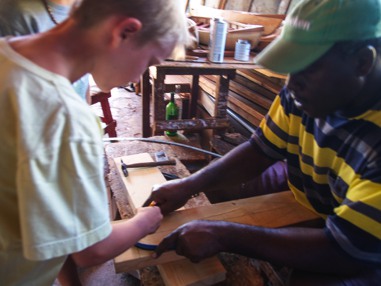
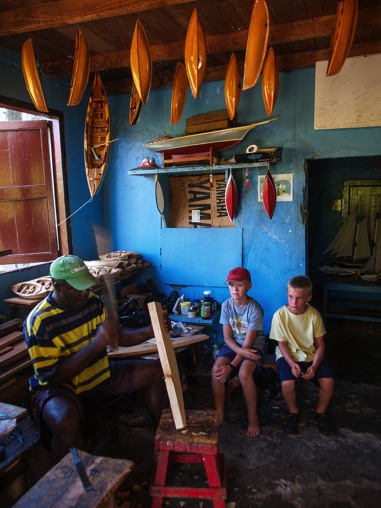
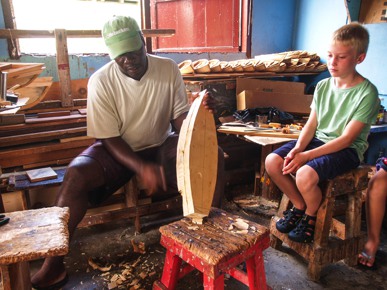
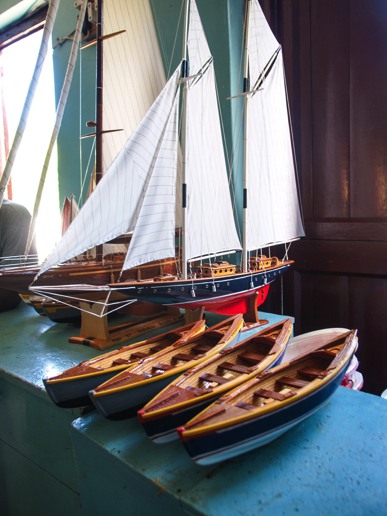
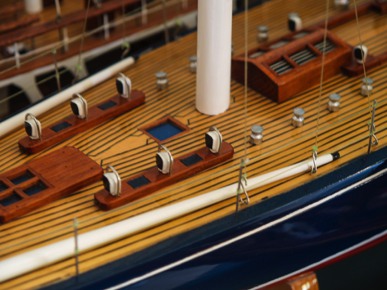
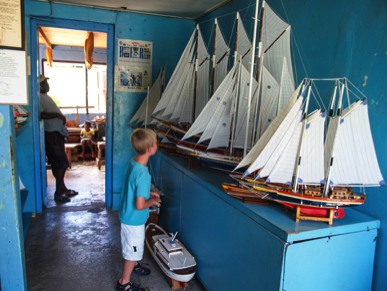
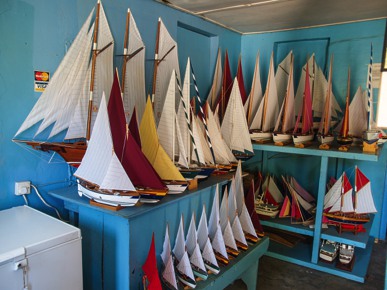
Benson Phillips and Havana Lyman take the first steps in building a model sail boat. In the foreground are half-finished models of traditional Bequia whale boats.

Havana today at 21.